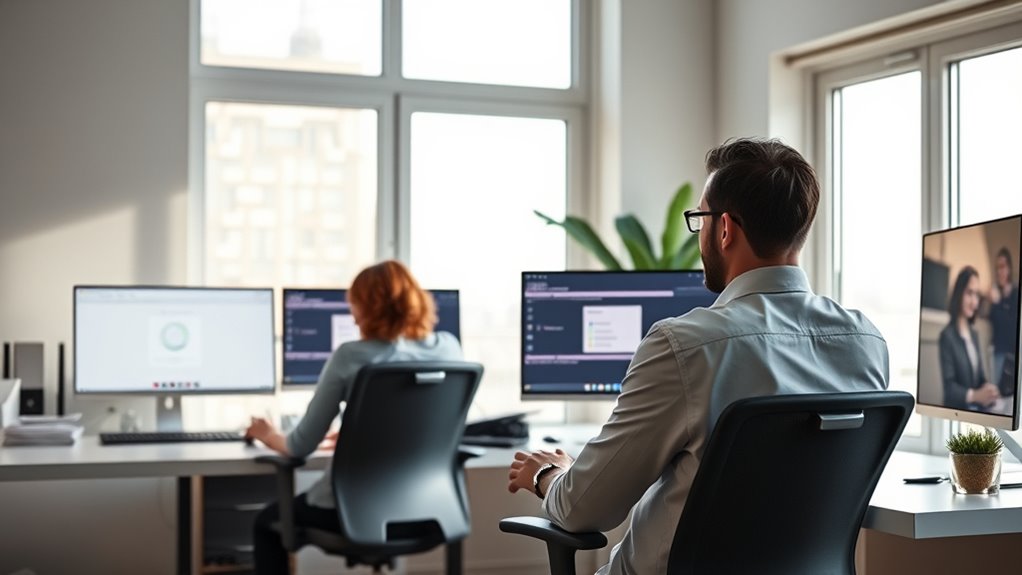Silent co-working and virtual focus sessions eliminate distractions, helping you concentrate better and complete tasks faster. These environments reduce stress, boost mental clarity, and create a disciplined work rhythm that sets a productive tone for Monday. By prioritizing soundproofing and ergonomic setups, you maintain high focus throughout the day. Keep exploring how these strategies can empower you to start your week with maximum efficiency and sustained momentum.
Key Takeaways
- Virtual focus sessions create dedicated quiet periods, minimizing distractions and boosting productivity at the start of the week.
- Silent co-working enhances mental clarity, helping team members complete tasks faster and set a productive tone for Monday.
- Structured focus times encourage disciplined work routines, leading to higher task completion rates on Mondays.
- Quiet environments reduce stress and mental clutter, supporting a calm, focused mindset for improved Monday output.
- Virtual focus sessions foster better team collaboration through mindful listening and trust, increasing overall early-week efficiency.
The Rise of Silent Co-Working in Modern Workspaces

As more professionals seek focused work environments, silent co-working spaces have gained popularity in modern workplaces. These spaces prioritize noise cancellation to eliminate distractions, allowing you to concentrate fully on your tasks. Unlike traditional offices, silent co-working areas are designed to minimize ambient sounds that can disrupt your workflow. This setup helps you maintain a high level of productivity and mental clarity throughout the day. The emphasis on quiet environments appeals to those who need deep focus without the interruptions of chatter or phone calls. As a result, more companies are adopting silent co-working models, recognizing their role in fostering efficient, distraction-free work. This trend reflects a growing understanding that a peaceful setting enhances both creativity and output. Additionally, incorporating soundproofing measures, such as noise cancellation technology, further improves the effectiveness of these spaces, which can also support mindset practices to maintain focus and positive energy. Creating a dedicated quiet zone within workplaces can enhance overall employee well-being and performance. Moreover, implementing soundproofing techniques according to industry standards can significantly elevate the environment’s tranquility.
How Virtual Focus Sessions Create Distraction-Free Environments

Virtual focus sessions have emerged as a popular solution for creating distraction-free work environments, especially for remote and hybrid teams. By setting dedicated times, you minimize interruptions and promote deep work. Using noise canceling headphones helps block out background noise, sharpening your focus. Visual cues, like shared screens or status indicators, signal when you’re in focus mode, discouraging unnecessary disruptions. These cues create a mental boundary that keeps distractions at bay. Consider this table to understand their impact:
| Noise Canceling Headphones | Visual Cues |
|---|---|
| Reduce auditory distractions | Signal focus without words |
| Enhance concentration | Communicate availability clearly |
| Create a personal sanctuary | Foster respect for focus time |
| Improve overall productivity | Maintain workflow continuity |
Additionally, implementing focused work techniques can further boost concentration during these sessions. For example, setting specific tasks and goals helps maintain clarity and direction. Incorporating distraction management strategies can help maintain a high level of focus throughout your work periods.
Enhancing Concentration and Productivity With Silent Work Modes

Implementing silent work modes can substantially boost your focus and productivity by minimizing external distractions. When you work in silence, you create a space for deep concentration, free from interruptions. Incorporate mindful breaks to reset your attention and prevent burnout, helping you stay engaged over longer periods. Using ambient sounds, such as soft music or white noise, can enhance your focus without disrupting your flow. These sounds mask background noise and help you maintain a steady rhythm of work. Silent work modes encourage you to enter a state of flow, where your attention is fully absorbed in tasks. By reducing interruptions and supporting mental clarity, you’ll find yourself completing tasks more efficiently and with greater quality. Additionally, understanding the importance of focused work can motivate you to adopt these silent practices regularly.
The Psychological Benefits of Quiet Work Settings

Quiet work settings offer significant psychological benefits by reducing stress and promoting mental well-being. When you work in a calm environment, you’re more likely to practice mindfulness exercises, which help center your thoughts and increase focus. This mindfulness fosters a sense of control and reduces feelings of overwhelm. Additionally, silence minimizes distractions, leading to lower stress levels and a calmer mindset. As a result, you can better manage anxiety and maintain a positive outlook. The mental clarity gained in quiet settings encourages a healthier work-life balance and boosts overall resilience. Incorporating sound effects libraries or ambient sounds can further enhance focus and create a more conducive workspace. Regularly practicing stress management techniques can also amplify these benefits and help sustain mental well-being, especially when paired with comfortable workspaces designed to reduce discomfort. Engaging in meditation practices during work breaks can deepen relaxation and enhance concentration throughout the day.
Strategies for Implementing Virtual Focus Sessions in Teams

Creating dedicated focus sessions for your team can substantially enhance productivity and mental clarity, especially in remote work environments. To implement these effectively, establish clear guidelines emphasizing mindful communication—encouraging team members to respect quiet periods and minimize interruptions. Set a consistent schedule for virtual focus sessions, ensuring everyone understands their purpose and expectations. Encourage team members to prepare ergonomic setups, like proper desks and chairs, to support sustained concentration. Use reliable tools to facilitate seamless communication during breaks or discussions, but keep the core focus time free of chatter. Regularly check in to gather feedback, adjusting the process as needed. Incorporating strategies such as ergonomic comfort and ergonomic setups can further improve engagement and efficiency during these sessions. Additionally, understanding sleep solutions for new parents can be beneficial for teams with new parents, helping them manage energy levels and maintain focus. Recognizing the importance of crypto market trends can also inform team planning and productivity strategies. By fostering an environment that values mindful communication and ergonomic comfort, you help your team maximize the benefits of silent co-working.
Real-Life Examples of Monday Productivity Boosts

Many teams see a noticeable jump in task completion on Mondays when they embrace silent co-working. This approach helps you stay focused and work more efficiently, often leading to faster results. Plus, it encourages better collaboration and communication without the usual distractions. Incorporating mindfulness practices can further enhance concentration during these sessions. Mindfulness practices can help maintain mental clarity and reduce stress, contributing to a more productive work environment. Additionally, setting clear goals at the start of these sessions can maximize focus and ensure everyone stays aligned on priorities. Creating a dedicated, ergonomic workspace can also improve comfort and boost overall productivity during these focused sessions. Fostering a sense of connection to the environment, even in a virtual setting, can also improve overall well-being and motivation.
Increased Task Completion Rates
When teams switch to silent co-working environments, they often notice a significant boost in their task completion rates on Mondays. Without the usual distractions, you can focus more deeply, finishing tasks faster and more efficiently. Incorporating mindful breaks helps you reset and maintain momentum, preventing burnout and boosting productivity. Additionally, ergonomic setups foster comfort, reducing physical strain and enabling longer periods of concentrated work. Teams report that these changes lead to a clearer sense of progress, as tasks are completed more consistently. This environment encourages a disciplined work rhythm, making it easier to hit weekly goals early in the week. Embracing focused communication strategies such as eco-friendly materials can further enhance focus and relaxation, contributing to a more productive start to the week. As a result, you’ll find yourself crossing off more items from your to-do list by Monday’s end, setting a strong tone for the week ahead.
Enhanced Focus and Efficiency
Switching to silent co-working environments often leads to noticeable improvements in focus and efficiency, especially at the start of the week. With noise cancellation, distractions fade away, allowing you to concentrate deeply on your tasks. Many find that ambient sound, whether from nature recordings or soft background music, helps maintain a steady workflow. This setup minimizes interruptions and mental clutter, so you can complete work faster and with greater accuracy. Real-life examples show that when you create a quiet, distraction-free space, your productivity spikes early in the week. You’ll notice fewer breaks and less time lost switching between tasks. Additionally, incorporating focused work strategies can further optimize your output. For example, some individuals find that setting specific goals for each session boosts their time management skills. Overall, this environment sharpens your focus, helping you accomplish more in less time and setting a productive tone for the days ahead. Engaging in proper equipment maintenance, such as ensuring your tools are clean and well-maintained, can also contribute to more efficient work sessions.
Positive Team Collaboration
Implementing silent co-working environments can considerably boost team collaboration and Monday productivity. Without the noise and interruptions, you can focus on mindful listening, truly hearing your teammates’ ideas and concerns. This fosters a culture of emotional intelligence, where everyone feels valued and understood. For example, teams that adopt virtual focus sessions report better communication and stronger trust, leading to more innovative solutions. When you practice mindful listening, you pick up on subtle cues, enabling more empathetic responses and reducing misunderstandings. Silent co-working encourages members to respect each other’s space while remaining engaged, promoting positive interactions. Over time, this approach builds a cohesive team that collaborates seamlessly, making Monday mornings more productive and less stressful. It’s a simple shift that transforms team dynamics and results.
Overcoming Common Challenges in Silent Co-Working Practices

Managing distractions and staying focused can be tough in silent co-working spaces, but you can establish routines to minimize interruptions. Building accountability by setting clear goals or check-ins helps keep you on track without breaking the quiet vibe. When you address these challenges head-on, silent co-working becomes more productive and enjoyable.
Managing Distractions Effectively
Although silent co-working fosters focus and reduces noise, it can also introduce unique distractions that challenge your concentration. To stay on track, practice mindful breathing when your attention drifts, helping you reset quickly. Personalizing your workspace can also minimize distractions—add a favorite mug, a plant, or calming visuals that make your environment inviting and less prone to wandering thoughts. If external noises become disruptive, use noise-canceling headphones or listen to ambient sounds to maintain your focus. Set clear boundaries with others in your virtual space, signaling when you need deep concentration. By intentionally managing these distractions, you create a more effective silent co-working experience, ensuring your productivity stays high and your focus remains sharp throughout your work session.
Building Accountability Systems
Building accountability systems is essential for overcoming the challenges of staying committed in silent co-working environments. To do this, establish regular check-ins or progress updates with peers or mentors, which keeps you responsible and motivated. Incorporate mindfulness routines into your day to enhance focus and reduce burnout, helping you stay on track consistently. Additionally, optimize your ergonomic setup to prevent discomfort and maintain energy levels throughout your work sessions. Use timers or accountability apps to track your work intervals and deadlines, reinforcing discipline without disrupting silence. By integrating these elements, you create a structured environment that encourages commitment while maintaining the serenity of silent co-working. This approach ensures you stay focused, productive, and accountable, even when working alone.
Measuring Success: Tracking Improvements in Work Output

To effectively measure success in a silent co-working environment, you need clear benchmarks that track work output over time. Performance metrics help you quantify productivity, while employee engagement indicates how motivated team members feel. Regularly reviewing these indicators lets you identify trends and areas for improvement. Use the table below to visualize your tracking approach:
| Metric | Measurement Method | Frequency |
|---|---|---|
| Tasks Completed | Count of finished tasks | Weekly |
| Focus Session Effectiveness | Post-session surveys | After each session |
| Engagement Levels | Participation in virtual chats | Monthly |
This structured approach keeps you aligned with your goals, ensuring silent co-working boosts both output and engagement.
Future Trends in Virtual Collaboration and Silent Work Initiatives

Advancements in virtual collaboration tools and silent work initiatives are shaping the future of how teams connect and operate remotely. Expect a continued focus on noise reduction, making virtual environments more conducive to concentration and productivity. New tools will emphasize seamless audio controls, background noise filtering, and customizable soundscapes to minimize distractions. Additionally, virtual ergonomics will become a key component, guiding users on creating comfortable, health-conscious setups at home. Future trends will prioritize ergonomic design features in software interfaces and hardware recommendations, reducing physical strain and enhancing focus during silent work sessions. These innovations will enable teams to maintain high productivity levels while supporting well-being, making remote work more sustainable and efficient for everyone involved.
Frequently Asked Questions
How Do Silent Co-Working Sessions Accommodate Different Work Styles?
You can accommodate different work styles by offering silent co-working sessions, which cater to personal work preferences. These sessions support both collaborative and individual work, allowing participants to choose when to focus quietly or engage quietly with others. By providing a flexible environment, you empower everyone to work in a way that suits them best, boosting productivity and comfort regardless of whether they thrive in solitude or teamwork.
What Tools Are Most Effective for Virtual Focus Sessions?
While some tools may seem simple, they’re your secret weapons for productivity hacks and focus techniques. Apps like Zoom or Microsoft Teams foster seamless connection, while timers like Pomodoro or Focusmate keep you on track. Even noise-canceling headphones help drown out distractions. These tools work together to create an environment of deep work, turning scattered hours into focused, productive sessions—making your Monday mornings far more effective.
Can Silent Co-Working Improve Team Communication?
You might wonder if silent co-working can improve team communication. It does, by emphasizing non-verbal cues like gestures and facial expressions, which often get overlooked in virtual settings. Plus, it helps bridge cultural differences, as everyone communicates through shared focus rather than words, fostering understanding and cohesion. This approach encourages active listening and attentiveness, making your team more connected and effective, even across different backgrounds.
How Do Remote Teams Maintain Engagement During Silent Work Periods?
Think of remote teams as a well-oiled machine—you need to keep the engine running smoothly. To maintain engagement during silent work periods, you should schedule regular social check-ins and encourage collaborative brainstorming sessions. These activities foster connection and creativity, ensuring team members stay motivated and engaged. By blending silent focus with social interaction, you keep everyone involved and energized, preventing the feeling of working in a vacuum.
What Privacy Considerations Exist in Virtual Silent Work Environments?
When working silently in virtual environments, privacy concerns and data security are key considerations. You need to guarantee sensitive information isn’t inadvertently shared or accessed by unauthorized individuals. Use secure platforms with encryption, implement strong password policies, and keep software updated. Be mindful of what you share on screens or in chats, and establish clear guidelines to protect everyone’s privacy, which helps maintain trust and confidentiality during silent work sessions.
Conclusion
Embracing silent co-working is like planting seeds in a quiet garden; with time, your focus blossoms into vibrant productivity. Virtual focus sessions clear the clutter, creating a tranquil pond where ideas flow smoothly. As you nurture this calm, your work becomes a steady stream, undisturbed by distractions. By cultivating these peaceful practices, you’ll watch your Monday output flourish like a well-tended landscape—bright, bold, and bound for growth.









